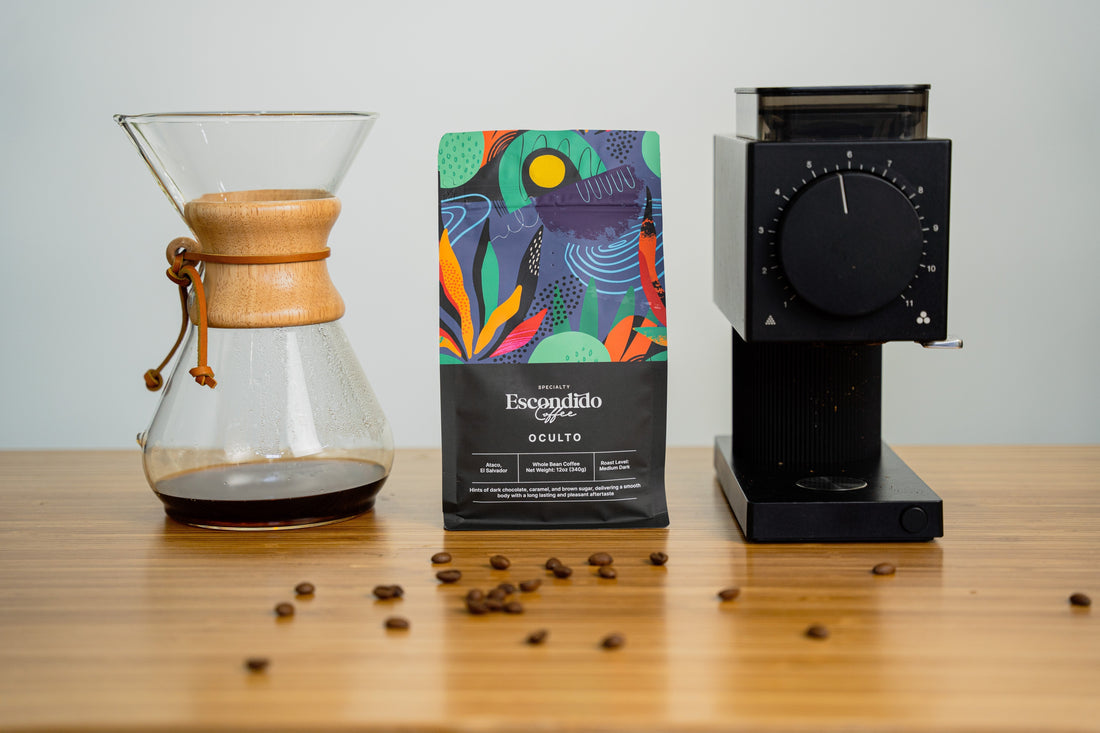
Chemex Coffee Brewing: History, Science, and Flavor Behind the Iconic Pour-Over
Share
Continuing our series on coffee extraction methods, we now explore the Chemex, a brewing device that bridges science and art. Known for its elegant glass hourglass shape, the Chemex is not only part of the permanent collection at the Museum of Modern Art in New York, but also a favorite among specialty coffee professionals. Its unique filter and design create a cup that is clean, bright, and nuanced, making it stand out in the world of manual brewing.
A Brief History of the Chemex
The Chemex was invented in 1941 by German chemist Dr. Peter Schlumbohm. Inspired by his knowledge of laboratory glassware and chemical extraction, Schlumbohm sought to design a coffee maker that combined function with beauty.
Its Borosilicate glass construction, wooden collar, and leather tie were not merely aesthetic choices, they reflected Schlumbohm’s goal of creating a brewer that embodied scientific precision and modern design. The Chemex was quickly recognized for its innovation, winning design awards and being featured in science and art museums worldwide.
How Chemex Extraction Works
The Chemex is a pour-over immersion-hybrid method that uses gravity to draw water through coffee grounds. What makes it unique is the special Chemex filter, which is 20–30% thicker than standard paper filters.
This thicker filter slows extraction, removes fine sediment and oils, and results in:
- Clean cup clarity
- Lighter body compared to French Press
- Bright, complex acidity
A study in the Journal of Food Research found that filter type significantly alters coffee flavor, with thicker paper filters producing higher clarity and lower lipid content compared to metal mesh.
Grind Size & Roast Preference
- Grind Size: Medium-coarse, resembling sea salt. Too fine and the filter clogs; too coarse and under-extraction occurs.
- Roast Levels: Light to medium roasts are ideal for Chemex, as the filter accentuates floral, fruity, and acidic notes. Dark roasts may taste overly flat due to the filtering of oils.
Water Quality & Temperature
Chemex brewing requires precise water control:
- Temperature: 92–96 °C (195–205 °F)
- Water-to-Coffee Ratio: The SCA recommends 1:15–1:17 ratio.
- Water Quality: Minerals matter. Balanced water enhances sweetness and acidity, while hard water mutes flavor.
Flavor Profile: What to Expect
Chemex coffee is defined by its clarity and delicacy:
- Bright acidity often highlighting citrus, floral, or fruity notes.
- Clean finish due to effective filtration of oils and fines.
- Light body, closer to tea-like than heavy immersion brews.
A sensory evaluation study found that Chemex brewing emphasizes higher acidity and floral notes, making it ideal for showcasing Ethiopian and Central American coffees.
Caffeine Content
Due to longer extraction times and filter efficiency, Chemex coffee generally has slightly less caffeine per ounce compared to espresso or French Press. Research shows that filter coffee averages 60–70 mg of caffeine per 100 mL, depending on brew ratio and bean origin.
Equipment & Budget
Chemex brewers range in price depending on size and design:
- Small models (3-cup): Affordable entry point.
-
Larger models (6–10 cups): Designed for group brewing.
The filters are proprietary and slightly more expensive than standard pour-over filters, but they are essential for the signature Chemex profile.

Chemex in Specialty Coffee Culture
The Chemex is more than a brewing device; it’s a symbol of specialty coffee culture. Its presence in cafés signals a dedication to precision, transparency, and artisanal craft. For roasters and cafés, showcasing coffee through Chemex emphasizes origin character and flavor clarity, appealing to consumers seeking elevated coffee experiences.
General Tasting Notes by Origin
- Ethiopia → floral, citrus, tea-like clarity.
- Colombia → balanced caramel, fruit, and chocolate.
- Costa Rica → crisp acidity, tropical notes.
- Kenya → vibrant blackcurrant, grapefruit.
Because of its delicate extraction, the Chemex is best for highlighting complex single-origin coffees.
Health Considerations
Since the Chemex uses thick paper filters, it removes nearly all cafestol and kahweol, the diterpenes associated with higher cholesterol. This makes it one of the healthiest brewing methods for regular consumption.
Conclusion
The Chemex is more than a brewer, it’s an icon of modern design, a champion of clean coffee flavors, and a scientific tool that extracts the brightest qualities of each bean. Its enduring popularity stems from its unique ability to merge chemistry, craftsmanship, and sensory elegance.
As our series continues, we’ll next explore the V60, another pour-over device with its own distinctive style and extraction science.
